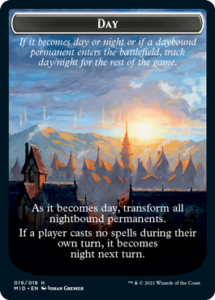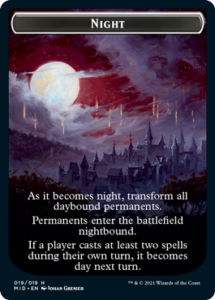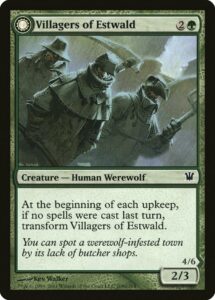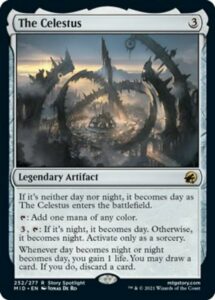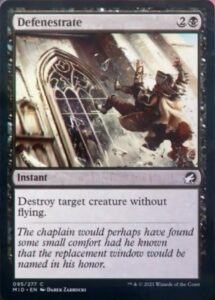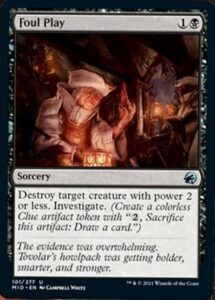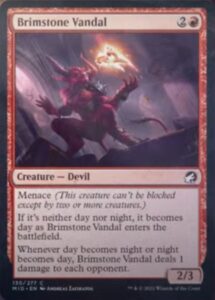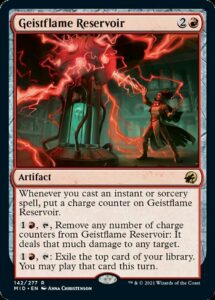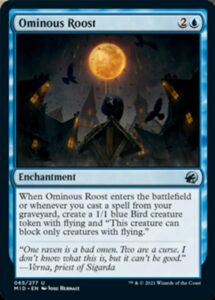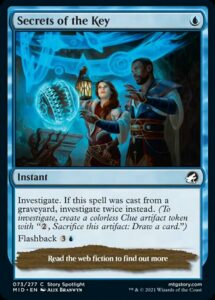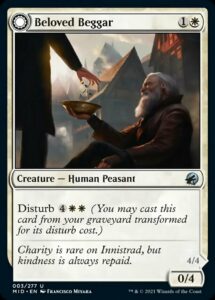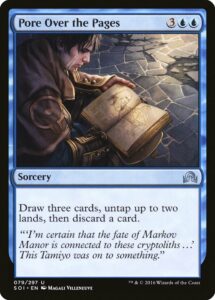Greetings, fellow humans! We’re once again at the bottom of a grim food chain, which means we’ve returned to Innistrad. It’s spoiler season, the first of two for Innistrad (the next likely begins next month)—meaning we’ve got several new mechanics and a whole slew of designs to digest.
It’s impossible to know exactly how well each will play or how powerful each will be (only playing can answer those questions), but it’s a useful and fun exercise to understand these cards, appreciate their context (both historical and current), and guesstimate just how things will play out.
Transformation transformed
Werewolves headline Innistrad: Midnight Hunt and were arguably the biggest mechanical innovation of the original Innistrad. Accordingly, they’re not only in greater volume than ever before, but their transformation mechanic has been overhauled. While Villagers of Estwald had constant upkeep triggers, Tavern Ruffian changes state as effortlessly as a permanent phases in. Much of the spirit of original werewolves is preserved in Daybound/Nightbound cards even though the mechanic plays fairly differently. So, what are the (perceived) advantages and disadvantages of this new mechanic?
Advantages of Day/Night
Mechanical consistency. Werewolves are always synced up. If you play a werewolf at night, it enters on its Nightbound side. Original Innistrad werewolves entered the battlefield on their human side, no matter what, only syncing up over time.
Narrative consistency. That mechanical inconsistency was also narratively weird, suggesting it was day and night simultaneously. Daybound/Nightbound ensures there is only one time on the battlefield (and no jetlagged werewolves).
No upkeep triggers. The upkeep is an often vestigial phase of the turn. It’s not the kind of thing new players need to be aware of, and it can be distracting taking game actions between untapping and drawing. Add in that each Innistrad werewolf generated its own upkeep trigger and you had busy beginnings of turns as each werewolf transformed one by one. Now, there are no triggers whatsoever (barring cards like Brutal Cathar).
Less to track. Daybound/Nightbound only cares about the actions of the player whose turn it is. That’s half as much activity to track in a two player game and a quarter as much in a four player game. It also means you have total control over what your werewolves do on your turn, rather than be at the mercy of your opponent chaining spells on your end step.
Creates affordances. With two mechanical keywords and a token that tracks a game state, Daybound/Nightbound allows cards like Gavony Dawnguard to exist. They don’t themselves transform, but they nevertheless care about the time of day.
Disadvantages of Day/Night
Busywork. In original Innistrad, you only tracked werewolf transformation while there was a werewolf to care about it. Daybound/Nightbound imposes a permanent game change à la the Monarch. This can create situations where players spend multiple turns (and mental energy) tracking Day/Night changes despite nothing caring, all because it might matter later on. Seemingly pointless busywork is a dangerous thing to impose upon players.
Problematic in small doses. The aforementioned tracking issue is compounded at low density. You could add one Brutal Cathar to a cube or Gavony Dawnguard to Modern Humans. But maybe you won’t just to avoid imposing a meaningless yet mandatory game action to every game (after they die).
Awkward wording. The Celestus is a relatively simple design in concept—it switches day and night, and rewards you for doing so. But it’s really wordy. Because it can’t have Daybound, it needs two lines to say, ‘set your watch.’ Because there is no word for day/night switching, it needs two lines to spell that out—and has to do so twice. Wizards was correct not to add a fifth vocabulary word to describe this day/night switch, but the awkward language impedes usage of the design affordance Day/Night creates.
The cards don’t explain themselves! Despite how wordy Day/Night-caring cards must be to explain themselves, Daybound/Nightbound doesn’t explain how it works! Magic has used truncated or simplified reminder text before, but this is akin to Companion—the mechanic could be revised and no text on cards would need to change. I like mechanics like Assembling Contraptions and Venture that use external components, but Day/Night spawning both overly wordy and insufficiently wordy cards makes the mechanic feel incomplete.
Mechanical inconsistency. Midnight Hunt werewolves work differently from Innistrad, Dark Ascension, and Shadows over Innistrad werewolves. This isn’t a problem in itself—Magic constantly reinvents itself. While Daybound/Nightbound has plenty of advantages, it’s not cleanly backwards compatible with older werewolves. That’s a disadvantage for a Magic increasingly focused on non-rotating formats.
Without playing with this new mechanic, one can’t say whether the advantages outweigh the disadvantages. My gut says that they do (else Wizards wouldn’t have made Daybound/Nightbound), but the combination of wordiness, insufficient explanation, four vocabulary words, and busywork have me curious about all the options Wizards cycled through before landing on this iteration.
Pure awesome
Let’s talk about something simpler than the major new mechanic.
I love common removal. I love powerful, format-defining removal like Grim Bounty, serviceable-but-unexciting removal like Tar Snare, and awkward removal like Certain Death. Each type serves an invaluable role in Limited’s structure. Rarely do we get something as perfect as Defenestrate.
The flavor is perfect. It’s same kind of story as Walk the Plank, except with a much cleaner narrative. It’s an enormous win if you know the delightful vocabulary word, but the art and flavor text nevertheless work to ensure the card makes sense if you don’t. Mechanically, this is an excellent marriage of a powerful, instant-speed removal spell with a clean restriction that ensures it’s not a universal answer.
It’s clean, it’s dripping with flavor, it’s charmingly humorous, it’s powerful, and it has a weakness. This is already one of my favorite designs ever. A+ work, Wizards!
Risk and reward
Continuing our look at removal, Foul Play is an excellent example of rehabilitation and enticement. Its clear forebear, Defeat, was fairly weak. It struggled to trade up on mana (most playable 3+ mana creatures have 3+ power), it’s vulnerable to combat tricks, and being sorcery speed compounds its issues.
Foul Play acknowledges these weaknesses as justification for dropping the mana cost to B, then adds Investigate to bring it back up to 1B. The result is the exciting prospect of a two-for-one that nevertheless bears all of Defeat‘s weaknesses. I like a card that offers the allure of power, but is secretly a skill-intensive test in format knowledge and sideboarding (in best of three).
This is a common
Last week, I had the pleasure of reviewing the original Innistrad. Back in 2011, New World Order was in full force and complexity at common was tightly managed. Common complexity trended upwards over time (with a brief downtick in Ixalan) and was intentionally increased in Ikoria. I couldn’t help but appreciate how much more restrained Innistrad’s commons were compared to today’s. Cards generally told one coherent, concise story. I recognize there’s a nostalgia bias and that I do appreciate higher complexity (especially in formats like Modern Horizons 2), but I fear that wordiness has crossed a line such that merely remembering everything that cards do requires excessive mental energy.
Brimstone Vandal feels emblematic of this trend. It doesn’t seem to be an especially important common, yet it’s covered in eight lines of text. Menace has no relevance to its two other abilities and likely to be forgotten due to the raw space they take up. The second ability is three lines just to ask you to ‘set your watch.’ The third ability is another three lines of text, half of which re-reference the Day/Night cycle introduced by the second ability (but which still require referencing a token to understand).
I like how Brimstone Vandal directly engages with the set’s core mechanic. It’s more interesting than a 2R 2/3 Menace with “at the beginning of your upkeep, deal 1 damage to each opponent.” But does this common warrant a massive wall of text, especially when so many other commons are similarly wordy? It doesn’t communicate much about the world, the name is actively unhelpful to experienced Magic players (“Vandal” usually communicates artifact destruction), and its mass of text obscures its effects.
and while we’re on the subject of wordiness…
Cards like Firemind’s Research, Dynavolt Tower, Pyromancer Ascension, and Spell Satchel tell the same, awesome story: “cast spells, get counters, convert counters into value.” Geistflame Reservoir follows suit but staples on a random bonus ability. Sure, impulsive draw synergizes by finding you spells and makes the card functional when you’re spell-light, but it makes the card is less defined, muddled between two unrelated stories.
In a vacuum, Magic will always have some awkward designs whose knobs are all fully dialed up (see Questing Beast). But I fear that too many cards are being maximized to the detriment of comprehension. Candletrap is more powerful than Choking Restraints and showcases a new mechanic, but there’s a novel on that card. Light Up the Night squeezes value out of Blaze, but requires several readings to remember.
I know I keep banging the drum of the danger of wordiness, but it’s been a growing concern for the past year, it’s the awkward center of Day/Night cards, and it keeps cropping up in preview season. I’m worried that Magic crossed the threshold of acceptable wordiness during the pandemic, but all-digital play obscured the issue.
Bird-ing Vengeance
On to simpler things…
I’m always down for uncommon build-around enchantments, and I appreciate how this calls back to Burning Vengeance, triggers on ETB (which is a substantial powerup), and creates high-flying tokens to prevent this from stalling out the game. This feels like a gently new take on an old Limited mainstay and excites me for all the new designs that could follow in its wake.
Two welcome returns
Flashback is among Magic’s best mechanics of all time, and the collective Gatewatch hasn’t been a major story element since 2017’s Hour of Devastation (unless you count War of the Spark’s overstuffed and disconnected story). Secrets of the Key brings both back, and I couldn’t be happier. We have yet to see how good the story is and how experimental Flashback will be (thus far, we’ve got multicolor Flashback costs, loyalty-Flashback, and Commander-Flashback, so there’s already innovation), but it’s exciting seeing both back.
As for the design, I like Secrets of the Key. It employs a beloved set mechanic, harkens back to Think Twice, and is actually two different spells in one. It’s a skill-tester, since it’s a three-for-one, has an absurdly high mana cost, and can be paid for in five installments. There’s also the question of how valuable Clues will be besides being cashed in for cards. That’s a lot of possibility space baked into a fundamentally simple design without being overwhelming. That’s another design win.
A lot of mechanics
We’ve talked at length about Daybound/Nightbound. Innistrad: Midnight Hunt brings back three deciduous mechanics in Investigate, Curse, and Transform as well as the oustanding Flashback. But there are also four more mechanics, one for each of the other five tribes.
Humans such as Candlelit Cavalry have Coven, a go-wide mechanic that tracks something brand new—diversity of power. Coven is likely only on GW cards.
Beloved Beggar introduces Disturb, a twist on Unearth and Transform which draws inspiration from Startled Awake. It’s the first time Innistrad’s spirits have had a mechanic and it’s a built-in card advantage engine. Disturb is likely only on WU cards.
Decayed is an all-downside keyword for UB Zombies such as Hobbling Zombie. The set provides ample ways to use these tokens beyond combat. While it’s a brand new keyword, it wasn’t included in the official mechanics article.
While BR vampires likely won’t get a formal keyword mechanic until Innistrad: Crimson Vow, cards like Arrogant Outlaw use a twist on Bloodthirst.
Individually, each of these mechanics is interesting. I like how Coven communicates human’s reliance of witchcraft, though it seems difficult to use and track. I like how Disturb uses Transform to make a cleaner and more flexible Embalm. Decayed tells a fantastic story, though it does suggest we’re in an Avacyn Restored-esque world where the zombies are dying off. And I like the callback to Bloodthirst for zombies—it feels like a nice, clean mini-mechanic that works better unkeyworded.
Collectively, it all feels excessive. Sets like Ravnica and Dragons of Tarkir use cycles of thin, color-specific mechanics to distinguish factions. Innistrad has always been modular, where each color split focus between tribal components and graveyard strategies. I’m not saying that Midnight Hunt can’t follow Ravnica’s structure, but the strength of Innistrad’s resonance and structure have thus far obviated that need. Combine the large array of mechanics to learn (even if all but Daybound/Nightbound are simple) with the large amount of wordy commons and it’s all a lot to take in.
When I have concerns about a set, I always feel better after reviewing it. It’s so easy to have knee-jerk emotional reactions that miss the incredible amount of work in every card and mechanic.
With Midnight Hunt, I’m sad to say the opposite is true. I was excited to return to one of my favorite worlds and loved the powerful-yet-simple teaser designs like Consider. Now that I’ve seen all the mechanics and dozens of cards, my excitement is tempered with concern. I know that analysis is no substitute for playtesting and am withholding judgment, but there’s a nagging worry that Magic is revisiting the issues of Time Spiral block through overuse of mechanics and overly wordy commons. Perhaps that’s less of an issue for an increasingly digital Magic, but as the pandemic slowly, eventually recedes, I intend to spend a lot less time playing digital Magic. It’d be a real shame if the tabletop experience suffered due to digital’s pandemic-fed surge.
Ultimately, we’ll see how Midnight Hunt lands when we play with it. I’m still eager to return to a beloved world with amazing mechanics and witness Teferi’s first feature story as a Gatewatch member. I’ve got more concerns that I thought I would, but there’s no guarantee which, if any, will bear out. And perhaps problems for me aren’t actually problems for Magic’s broader player bases. Only time and playtesting will tell.
Zachary Barash is a New York City-based game designer and the commissioner of Team Draft League. He designs for Kingdom Death: Monster, has a Game Design MFA from the NYU Game Center, and does freelance game design. When the stars align, he streams Magic (but the stars align way less often than he’d like).

